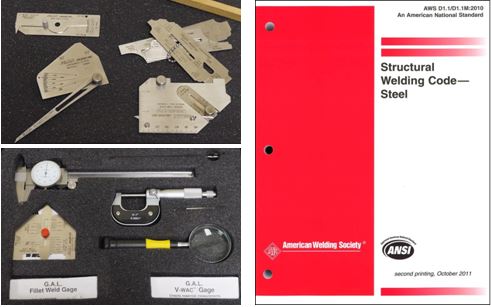The Role of Welding Inspection Racine in Preventing Structural Failings
The Role of Welding Inspection Racine in Preventing Structural Failings
Blog Article
Ingenious Approaches to Fillet Weld Inspection and Screening: Enhancing Weld Top Quality and Conformity Specifications
In the realm of welding, the quality and stability of fillet welds play an essential function in guaranteeing the structural strength and dependability of numerous industrial parts. With the constant drive for enhanced effectiveness and conformity with stringent requirements, the expedition of cutting-edge approaches to fillet weld examination and screening has actually ended up being essential. As industries progress, the typical approaches may no longer be sufficient in meeting the needs of contemporary welding applications. By embracing innovative innovations and methodologies, a brand-new perspective of opportunities emerges in the realm of weld high quality analysis and adherence to compliance requirements.

Advanced Non-Destructive Screening Techniques
Making use of modern modern technologies, progressed non-destructive screening approaches play a crucial duty in ensuring the stability and quality of fillet welds. These approaches, such as phased variety ultrasonic testing (PAUT) and magnetic bit testing (MPT), offer detailed understandings right into the weld's internal framework without causing any kind of damage to the product. PAUT, for instance, utilizes numerous ultrasonic elements to evaluate the weld from various angles, giving a detailed visualization of possible problems like lack of combination or cracks.
By using these sophisticated non-destructive screening strategies, weld assessors can accurately analyze the high quality of fillet welds, making certain compliance with market criteria and guidelines. The capability to detect problems early on not just improves weld quality yet additionally prevents expensive rework or failures in structural stability, underscoring the value of these innovative testing methods in welding assessments.
Robotics and Automation in Evaluation
The combination of robotics and automation has actually changed the examination procedure for fillet welds, boosting efficiency and accuracy in high quality assessment. Robotics use precise control and repeatability in inspecting welds, guaranteeing consistent and reputable results. Automated systems can be programmed to follow details assessment courses, making certain thorough insurance coverage of welds and reducing the risk of human mistake.
Robot evaluation systems geared up with advanced sensing units can detect and determine weld attributes with high accuracy, offering thorough information for analysis. These systems can recognize problems such as splits, lack of fusion, and porosity, enabling punctual rehabilitative activities to be taken. Furthermore, robotics and automation allow for real-time data collection and evaluation, offering prompt comments to operators and promoting fast decision-making procedures.
In addition, using robotics and automation in fillet weld examination enhances total productivity by lowering assessment times and enhancing examination throughput. By streamlining the assessment procedure, suppliers can guarantee weld top quality and conformity criteria are met effectively, inevitably leading to set you back savings and improved item top quality.
Utilizing Artificial Intelligence for Evaluation
Artificial intelligence plays a pivotal function in enhancing the effectiveness and precision of analysis in fillet weld my sources evaluation processes. AI algorithms can rapidly process large quantities of information from weld inspections, finding flaws or variances that may be testing to recognize with the naked eye.
Additionally, AI systems can discover from past inspection information, continuously improving their capability to identify prospective flaws and discrepancies in fillet welds. This adaptive understanding ability improves the total quality control procedure, lowering the probability of human error and making certain that welds satisfy the needed requirements. By incorporating synthetic intelligence right into fillet weld analysis, sectors can accomplish higher degrees of effectiveness, uniformity, and compliance in their inspection techniques.
Portable Devices for On-Site Assessment
Enhancing area examination effectiveness, the adoption of mobile devices revolutionizes on-site analysis processes for fillet welds. These tools offer versatility and convenience, enabling assessors to carry out extensive evaluations in numerous locations, including tough or remote environments. Portable devices such as ultrasonic testing gadgets, magnetic particle evaluation tools, and digital radiography systems give real-time data and high-resolution imaging abilities, making it possible for quick decision-making and instant comments on weld top quality.
One significant advantage of mobile tools is their capacity to simplify evaluation procedures, minimizing downtime and improving total performance. Inspectors can quickly transfer these tools to various task websites, removing the requirement for moving heavy equipment or parts to off-site facilities. In addition, the mobility of these tools promotes cost-effectiveness by minimizing transportation costs and accelerating inspection timelines.
Furthermore, making use of portable tools for on-site inspection promotes aggressive quality assurance measures, as inspectors can without delay recognize and attend to any kind of possible welding defects or disparities. By including these innovative technologies right into on-site assessment practices, welding professionals can guarantee conformity with market standards and boost weld high quality, ultimately causing boosted architectural honesty and safety and security in different welding applications.

Combination of Information Administration Equipment
Having actually maximized on-site examination procedures via the usage of portable tools, the next stage includes the smooth assimilation of information administration systems to better enhance performance and information evaluation capacities in find this fillet weld assessment and testing. By incorporating information management systems right into the examination procedure, companies can enhance information collection, storage, and evaluation. This combination permits real-time monitoring of weld quality, prompt recognition of problems, and prompt decision-making to rectify any kind of problems that might emerge throughout the assessment procedure.
The combination of information administration systems makes it possible for seamless communication between various stakeholders included in the inspection process, cultivating cooperation and enhancing overall top quality control measures. Ultimately, the integration of information administration systems offers to elevate the criteria of fillet weld inspection and screening, making certain compliance with here are the findings market guidelines and improving weld high quality.
Final Thought
In final thought, innovative methods to fillet weld inspection and screening have actually significantly enhanced weld quality and compliance criteria. Advanced non-destructive screening techniques, robotics, automation, expert system, portable devices, and information administration systems have revolutionized the means weld examinations are carried out. By using these innovations, sectors can guarantee that welds satisfy the needed quality criteria and guidelines, eventually improving general efficiency and safety and security in welding processes.
By utilizing these advanced non-destructive screening methods, weld inspectors can precisely evaluate the high quality of fillet welds, guaranteeing conformity with market standards and guidelines - Welding Inspection Racine. Mobile tools such as ultrasonic testing gadgets, magnetic fragment evaluation equipment, and electronic radiography systems give real-time data and high-resolution imaging capacities, enabling fast decision-making and prompt comments on weld quality
Having actually maximized on-site examination processes via the use of mobile tools, the next stage involves the seamless assimilation of data management systems to additionally enhance effectiveness and data evaluation capabilities in fillet weld examination and testing. Eventually, the assimilation of data monitoring systems serves to raise the criteria of fillet weld evaluation and screening, ensuring conformity with sector regulations and enhancing weld high quality.
In verdict, innovative techniques to fillet weld inspection and testing have substantially boosted weld quality and compliance requirements. (Welding Inspection Racine)
Report this page